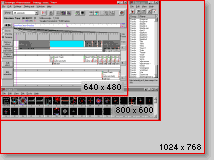![]()

| This page Docking stations Port replicators Screens Audio Specific models Related pages IBM ThinkPad docking stations |
Lasershow Designer can be used with a notebook computer, as long as it has a docking station which can accept the QuadMod32 board. Remember that the QM32 is a full-length ISA (standard AT-type) card. Docking stations are relatively rare; those that take full-length cards are even rarer. The notebook/docking station must also be able to take a CD-ROM drive, if you want to run Showtime shows that use synchronized audio CDs (like Lightspeed's "Creation" demo). Docking stations |
|
|
|
Most ads barely
mention docking stations. Most magazine reviews ignore them. So you'll have to do some
work to find out if a docking station is available, if it takes full-length cards (and how
many), how much it costs, what other features (drive bay for CD-ROM or other options) are
available, etc. Port replicators |
|
|
|
You may see "port
replicators". These are micro-docking stations, which just duplicate the ports on a
notebook making it faster to hook up to a desktop configuration. Port replicators have no
slots or bays, so they are useless for LD's needs. (In some IBM ThinkPad notebooks, a port
replicator is required in order to use the docking station; see IBM animation below.) |
|
|
|
||
|
|
The screen is important. You can have dual-scan (also called DSTN) or active-matrix (also called TFT). There are three main sizes of screens: 640 x 400 (VGA), 800 x 600 (SVGA) and 1024 x 768 (XVGA). You also need to check the maximum colors available at various sizes. Dual-scan vs. active-matrix |
|
|
|
Dual-scan is less expensive, but
colors look comparatively faded, and fast-moving objects such as the mouse pointer can
fade out. Usually, there is a "sweet spot" for viewing so only one person can
see the screen image well. Active-matrix adds $300 to $1000. Colors are rich and bright, with no movement fade. Four or five people can see the screen simultaneously, making active-matrix essential if you'll be doing a lot of demos. Size |
|
 Comparison of VGA, SVGA and XVGA. The XVGA 1024 x 768 screen provides 2.5 times more area than the VGA 640 x 480 screen. |
We strongly recommend running LD
on an SVGA (800 x 600) or XVGA (1024 x 768) screen. Most notebooks can run an external
monitor at SVGA resolution. If you are using LD mostly in the studio, you can save money
by getting a notebook with a poor screen (dual-scan VGA) and using a separate monitor at
SVGA resolution. When on the road, the dual-scan VGA screen will be useful enough to edit
and do basic changes. However, if you want no monitor hassle, then pay extra to get a large active-matrix SVGA. This way you never need a monitor, and you can do lots of work comfortably in the field. A study by Dell has concluded that the optimum screen size for VGA is 10", for SVGA is 12" and for XVGA is 14". Any smaller, and type is hard to read. Any larger, and type is "blocky" as the individual pixels are enlarged. Some systems have a "virtual screen" where you only see a limited view (e.g., 640 x 480) but you can scroll around a larger screen (e.g., 800 x 600). This feature is marginally useful; you should concentrate on the real screen size and not rely on a larger virtual screen. Colors |
|
|
|
Lasershow Designer works best in
higher color modes, of 32,000 colors or better. This eliminates problems with colors
changing when importing bitmaps. You can run LD in 256-color mode but you might have the
color-change problem. We do not recommend 16-color mode for full-time use. Therefore, check what the maximum color resolution is at the highest screen resolution. For example, if you can only get 16 colors in 800 x 600 mode, then for LD use it is not recommended. |
|
|
|
||
|
|
AUDIO There will be
built-in speakers either on the notebook, the docking station or both. They work fine for
studio use but are barely acceptable for an important presentation. If you're bringing
along a laser projector (to a demo, for example), be sure to also bring good amplifed
speakers. You want powerful sound to reinforce your powerful images. |
|
|
|
||
|
|
SPECIFIC MODELS To find computers which use docking stations, search at
sites such as IDG (PC Magazine, Computer Shopper) using the keyword "docking
station". Printed PC magazines also have reviews of portables, including the ones
listed below. Close examination of pictures in the reviews and ads will help you find
models sold by different companies but made by the same manufacturer (e.g., DTK, EPS,
Fosa). |
|